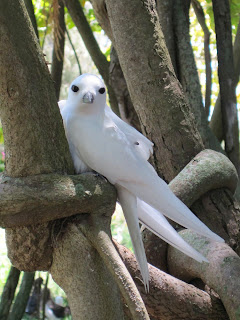The bird is also known as Manu o Ku, and is an important bird in Polynesian navigation. In the morning, Manu o Ku is generally flying away from land for a day of fishing. Toward the end of the day the bird is returning to land. This information helps a navigator know which way land is.
When I first arrived on Midway the White Terns were pairing up, and some still are. A male and female Tern, who are thinking about choosing each other as mates, fly together in the blue sky, sometimes really high. It's amazing to see them! They are flying very close together, almost wing tip to wing tip, and are making dips and circles, never crashing into each other. I don't know how they do it!
 |
| White Terns mating in an ironwood tree. |
 |
| banyan tree, with my bicycle for scale |
On Wednesday June 23, as I was exploring Midway's Sand Island, I bicycled past a beautiful, big banyan tree. Some of the hanging aerial roots were interesting because someone long ago must have tied a few young ones into knots, and they continued to grow that way.

A Fairy Tern was perched on one of these big knots. Something looked a little different about this Fairy Tern. I crept closer and took this picture on the right. Notice how the stomach feathers are fluffed out? This bird was sitting on an egg!
I didn't want to disturb it, so I walked away slowly. The next day I bicycled back to see how it was doing. And look who had hatched out! --a downy, tan chick! I decided to visit the Banyan Chick, as I called it, every once in awhile to watch it grow up. I'm sorry if my pictures are a little fuzzy. I had to stand far away from the chick sometimes and use the camera's zoom. If I got too close to the chick, the parents dive-bombed me!




Today is Wednesday, August 11, seven weeks after I first noticed the parent Tern sitting on the egg. Here's what Banyan Chick looks like now. Getting some nice, white feathers among the tan down, don't you think?!





No comments:
Post a Comment